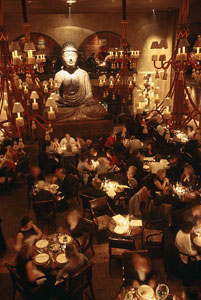“Dhammo Have Rakkati Dhamma Chari”
Malin Abayatunga, writing from Melbourne in the Sunday Times of July 11, expresses his concern about the opening of “Buddha Bars” and using Buddha statues as ornaments by non-Buddhists.
His experience at the Gurkha restaurant, Flinders Street, Melbourne, where an image of Buddha decorates the entrance, and his statement, “I will not have a drink or meal here”, somewhat surprised me, for, as a Buddhist I usually get ‘appalled and disgusted’ only when I see in restaurants around the globe, live animals being exhibited for patrons to earmark for preparation of a dish.
Apart from Abayatunga, there have been quite a large number of enraged Buddhists who view this as a serious act that hurts Buddhist sentiments and desecrates Buddhism.
“To conquer the hearts of people”, the theme put forward by George E. Entertainment Group, the Paris-based owning company of the Buddha Bar chain, has created further distress. In addition to operating Buddha Bars in all major cities in the world, the company also markets ‘Buddha bar music fiesta’ products, MP3, CDs and albums depicting Buddha images on the cover. It has sold millions of copies of the “Naked Rhythm on B/B IX” CD alone, since the first Buddha Bar appeared in the mid-nineties in Paris. The company has already announced its plans to set up spa treatment, dubbed ‘Buddhattitude’ as its next project.
Numerous appeals and protest campaigns launched by many Buddhist groups received no response. Citing the “freedom of expression” clause, the company says its patrons have a right to drink and dance around any statue or image erected within the premises. (A huge Buddha statue presides over the plush lounge, bars and vast dining rooms of ‘Buddha Bar’ and almost every wall features a Buddha image as a standard). Legal suits failed too on the premise of ‘patent rights’ or ‘Registered with the Directorate General of intellectual property rights’.
The only instance of successful agitation recorded so far was in Indonesia, where despite Megawati Sukharno’s two daughters being co-owners, the protest led by the Buddhist minority managed to change the name in Jakarta’s franchise Buddha Bar. As reported, the Sri Lankan government has obtained reports from its embassies on operations of Buddha bars and is planning suitable action. Buddha Bar is a private chain hence taking up the matter with the relevant governments through diplomacy will not be helpful. Given the circumstances, the only option is to deal with the owners privately.
The Hollywood film, ‘The Da Vinci Code’, based on the best-selling novel by Dan Brown and Satanic Verses by Salman Rushdie were banned in Sri Lanka after appeals from Catholic and Islamic leaders.
Their protests gave undue publicity to the books and the film. Similarly, the government’s refusal to issue a visa to R&B pop-star Akon for offending Buddhists with his video featuring two scantily-clad women dancing near a Buddha statue, made his song “Sexy chicks” a hit and the DVD sold like ‘hot-cakes’ on the Pettah pavements. Instead of getting offended one could have simply imagined ‘Tanha and Arathi’ performing (in the absence of ‘Raga’) in Sath-sathiya, as depicted in paintings at every temple.
The brand managers of Buddha Bar owners will be happy over the free ‘promotional effects’ their brand enjoys through protest campaigns. The best option is to adhere to the saying that “those who abide by Dhamma will be protected by Dhamma”.
Buddha told us to make an effort to see objects with full awareness and mindfulness and with direct application of bare attention (Sathi Sampajana) and with wise attention, (yoniso manasikara), leaving no room for sagnna to appear as a ‘disturbance’ , where our memory plays the main role, preventing our direct view. Be aware of your judgments, prejudices, likes and dislikes.
The problem is when we see something, the view is the result of comparison, condemnation, judgment and evaluation. To be fully aware is to see at the very moment this process of judging, evaluating, conformity, acceptance or denial. Practice will soon make one realize the true nature of things, leading to final liberation.
How come a painter or sculptor creates an image of the Buddha without having any knowledge of the actual figure? When we start understanding His Dhamma, it will create an indelible ‘image’ of the Lord Buddha within us -- an image that cannot be exposed to all types of misuse. Once this image gets impregnated in our minds, anybody dancing, dining or making merry before statues will not shake us.
K. K. S. Perera,
Panadura |


